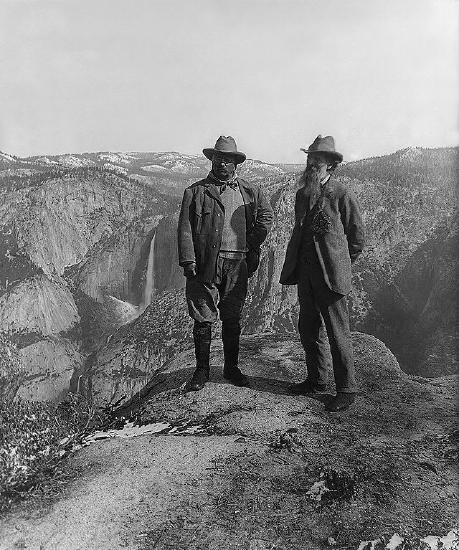1.4: History of US Conservation
- Page ID
- 72418
Introduction
It is not uncommon to think of the sustainability paradigm as being a recent interpretation of environmental policy, one that was given credence by the United Nations report "Our Common Future" (the Brundtland Report) when it was first presented in 1987. However, it would be a mistake to conclude that sustainability as a mental construct and policy framework for envisioning the relationship of humans and nature came into being suddenly and at a single moment in time. Most environmental historians who have studied U.S. policy have discerned at least three distinct periods during which new concepts and ideas, scientific understandings, technological advances, political institutions, and laws and regulations came or were brought into being in order to understand and manage human impacts on the environment.
The American conservation movement: This 19th century movement had the main objective for conservation of American land and resources, it grew from opposite philosophies. On one side you had people like Gifford Pinchot (first head of the US National Forest Service) that were very pragmatic about their desire for conservation. For example, these people observed that policies for harvesting some resource (like lumber) were not sustainable, so they began conservation/sustainability research and new policies so the resource would not run out in the foreseeable future. On the other side were people like John Muir and Theodore Roosevelt that saw land/habitats/wildlife as intrinsic entities, meaning that had value in their own right (meaning nothing to do with money).

Figure 1.4.1: U.S. President Theodore Roosevelt (left) and nature preservationist John Muir, founder of the Sierra Club, on Glacier Point in Yosemite National Park. In the background: Upper and lower Yosemite Falls, 1903. (Public Domain, Wikimedia Commons)
The rise of environmental risk management as a basis for policy: The beginnings of environmental risk management can be traced to the fields of public health, industrial hygiene, and sanitary engineering, which came into prominence in the latter decades of the 19th century and beginning of the 20th. The spread of disease was a particularly troublesome problem as the country continued to urbanize. In addition, environmental scientists of the day were alarmed by the extent and degree of damage that they were documenting. The publication of Silent Spring in 1962 by Rachel Carson (1907-1964)(Figure 1.4.2), about the impact of the widespread and indiscriminate use of pesticides, was a watershed moment, bringing environmental concerns before a large portion of the American, and global, public. Carson, collected scientifically documented evidence on the effects of pesticides, particularly DDT, heptachlor, and dieldrin, on humans and mammals, and the systemic disruption they caused to ecosystems. Silent Spring is credited with bringing about a ban on the use of DDT in the United States, and setting in motion a chain of events that would ultimately result in the transformation of environmental public policy from one based on the problems and attitudes that brought about nineteenth century conservation, to one based on the management of risks from chemical toxins. The U.S. Environmental Protection Agency was established in 1970, just eight years after the publication of Silent Spring. The same year Earth Day was created.

Figure 1.4.2: Rachel Carson, author of "The Sea Around Us" and "Silent Spring." She was a biologist for the US Fish and Wildlife Service and an author. Her book "Silent Spring" is credited with bringing environmental awareness to the forefront of the public. (Photo 1940 US FWS, Public Domain)
The integration of social and economic factors to create what we now refer to as the sustainability paradigm: Eventually, we (humanity) realized that in order to solve environmental issues (like ones identified by Rachel Carson), that the "human factors" (both social and economical) had to be accounted for. This is what defines the sustainability paradigm: environmental, social, and economic disciplines. Only Band-Aid solutions can be applied if we only take a one-minded approach.
History of Environmental Policy
Environmental policies are typically driven by problems of the day, real and perceived, that require systemic solutions. For example:
- Early conservationists were alarmed at the inefficiencies of human resource management and the encroachment of humans on unspoiled lands... Leading to conservation legislation.
- During the 20th century many groups (scientists, economists, politicians, and ordinary citizens) became alarmed and fearful of the consequences of toxic pollutant loads to the environment that included localized effects on human health and well-being... Leading to clean air and water legislation.
- As we proceed into the 21st century, an array of complex problems that have the potential to alter substantially the structure and well-being of large segments of human societies, calls for a renewal and reassessment of our approach to environmental policy.
This has, thus far, proven to be a difficult transition. Many of these complex problems have multiple causes and impacts, affect some groups of people more than others, are economically demanding, and are often not as visibly apparent to casual observers as previous impacts, nor are the benefits perceived to be commensurate with costs. Devising a regulatory strategy for such problems requires an adaptive and flexible approach that current laws do not foster.
Table \(\PageIndex{a}\): Table illustrating evolution of environmental policy. Table by Sustainability: A Comprehensive Foundation in Openstax (CC-BY).
| 1850-1920 | 1960-1990 | 1990-Present | |
|---|---|---|---|
|
Focus |
Conservation/sanitation | Media/site/problem specific | Complex regional/ global problems |
| Outcome | Land preservation/efficiency/control of disease | Manage anthropocentric and ecological risk | Global sustainable development |
| Principal Activity | Resource management reform/simple contaminant controls | Compliance/remediation/technological emphasis on problem solving | Integration of social, economic, and technological information for holistic problem solving |
| Economic Focus | Profit maximization/public health | Cost minimization | Strategic investments/long-term societal well-being |
| Regulatory Activity | Low | Heavy | Adaptive and flexible |
| Conceptual Model | Expansion vs preservation | Command and control | Systems/life cycle approach |
| Disciplinary Approach | Disciplinary and insular | Multidisciplinary | Interdisciplinary/integrative |
Table \(\PageIndex{b}\): Table illustrating major environmental legislation, society, and organization conceptions. Table by Rachel Schleiger (CC-BY-NC).
|
Year |
Policy/Society/Organization Conception |
|---|---|
| 1899 |
Refuse Act |
| 1905 | National Forest Service |
| 1916 | National Park Service |
| 1918 | Migratory Bird Treaty Act |
| 1930's | State Parks |
| 1948 | Federal Water Pollution Control Act |
| 1950 | The Nature Conservancy |
| 1955 | Air Pollution Control Act |
| 1961 | World Wildlife Federation |
| 1963 | Clean Air Act (1970, 1977, 1990 updates) |
| 1965 | Solid Waste Disposal Act (1976 update) |
| 1965 | Water Quality Act (1987 update) |
| 1967 | Air Quality Act |
| 1969 | National Environmental Policy Act |
| 1970 | Occupational Safety and Health Act |
| 1970 | Environmental Protection Agency |
| 1971 | Occupational Safety and Health Administration |
| 1972 | Consumer Product Safety Act |
| 1972 | Federal Insecticide, Fungicide, and Rodenticide Act |
| 1972 | Clean Water Act (1977 update) |
| 1972 | Noise Control Act |
| 1973 | Endangered Species Act |
| 1974 | Safe Drinking Water Act (1986, 1996 updates) |
| 1975 | Hazardous Materials Transportation Act |
| 1976 | Resource Conservation and Recovery Act |
| 1976 | Toxic Substances Control Act |
| 1980 | CERCLA (Superfund) |
| 1984 | Hazardous and Solid Waste Amendments |
| 1986 | Superfund Amendments and Reauthorization Act |
| 1986 | Emergency Wetlands Resources Act |
| 1990 | Oil Pollution Act |
| 1993 | North American Free Trade Agreement |
| 2003 | Healthy Forest Initiative |
Attribution
Modified by Rachel Schleiger from Sustainability: A Comprehensive Foundation by Openstax (CC-BY).


